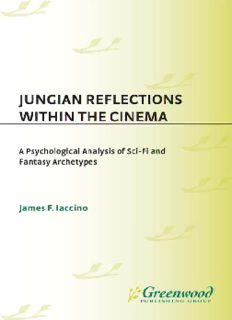
Jungian Reflections within the Cinema: A Psychological Analysis of Sci-Fi and Fantasy Archetypes PDF
Preview Jungian Reflections within the Cinema: A Psychological Analysis of Sci-Fi and Fantasy Archetypes
JONGIAN REFLECTIONS WITHIN THE CINEMA This page intentionally left blank Jungian Reflections within the Cinema A Psychological Analysis of Sci-Fi and Fantasy Archetypes JAMES F IACCINO Westport, Connecticut RRAEGER5 London Library of Congress Cataloging-in-Publication Data Iaccino, James F. Jungian reflections within the cinema : a psychological analysis of sci-fi and fantasy archetypes / James F. Iaccino. p. cm. Includes bibliographical references and index. ISBN 0-275-95048-4 (alk. paper) 1. Science fiction films—History and criticism. 2. Fantastic films—History and criticism. 3. Archetype (Psychology) in motion pictures. I. Title. PN1995.9.S26I23 1998 791.43'65—dc21 97-41705 British Library Cataloguing in Publication Data is available. Copyright © 1998 by James F. Iaccino All rights reserved. No portion of this book may be reproduced, by any process or technique, without the express written consent of the publisher. Library of Congress Catalog Card Number: 97-41705 ISBN: 0-275-95048-4 First published in 1998 Praeger Publishers, 88 Post Road West, Westport, CT 06881 An imprint of Greenwood Publishing Group, Inc. Printed in the United States of America (fir The paper used in this book complies with the Permanent Paper Standard issued by the National Information Standards Organization (Z39.48-1984). 10 9 8 7 6 5 4 32 As always: To my archetypal companion Michele, and our four primordial children: Jon, Nicole, Kaitlin, and Rebecca This page intentionally left blank Contents Preface ix Introduction to Jungian Archetypes xi Part One A Jungian Analysis of Science-Fiction Films Chapter 1. The Star Wars Trilogy: The Space-Father Archetype 3 Chapter 2. The Star Trek Movies: In Search of the Creator Archetype 15 Chapter 3. Planet of the Apes: The Evolution of an Archetypal Shadow Species 35 Chapter 4. From Logan's Run to Battlestar: Galactica: Archetypal Rebellions Against Shadow Destroyers 55 Part Two A Jungian Analysis of Fantasy Films Chapter 5. Back to the Future Again and Again: Archetypal Exploits of Alchemic Travelers 79 viii Contents Chapter 6. From Superman to Batman: Divided Superhero Archetypes 93 Chapter 7. The Indiana Jones and Highlander Chronicles: Quests for the Holy Grail Archetype 121 Chapter 8. The Omen Trilogy: The Growth of the Demon Child Archetype 147 Part Three A Jungian Analysis of Television Archetypes Chapter 9. Shadow Pursuers: Fanatical Figures in The Fugitive, The Incredible Hulk, Starman, and The Pretender 165 Final Remarks 187 Appendix: Science-Fiction and Fantasy Filmography 189 Bibliography 197 Index 207 Preface When I was writing my book entitled Psychological Reflections on Cine matic Terror: Jungian Archetypes in Horror Films for Praeger Publishers in 1994,1 knew that I would not be able to do justice to the psychoanalytic theory by focusing on just one movie genre. Though the correlation be tween Carl Jung's primordial images and horror story lines was a striking one, I felt that other treatments could be considered along the same lines of investigation as the first work. Thus, the purpose behind Jungian Re flections within the Cinema is primarily to extend the archetypal analysis to a number of movie categories, ranging from science-fiction to fantasy films. There is even a section on television series that have tried to emulate the larger-than-life movies in plot and character development. In the proc ess of broadening my scope, I hope that I have succeeded in providing greater substance and three-dimensional life to Jung's extensive list of ar chetypes not only to this present generation of readers, but also to those who will follow. The format of Jungian Reflections within the Cinema is similar to the previous text. Each chapter will concentrate exclusively on an archetype via a package of films that illustrate its essential contents. For instance, the Jungian shadow has been represented in various movies as an oppressive society (Logan's Run) or an alien race {Battlestar: Galactica) that is hell bent on maintaining control and order in the universe. Archetypal heroes like Logan-5 or Commander Adama are inserted into the stories not only
Description: